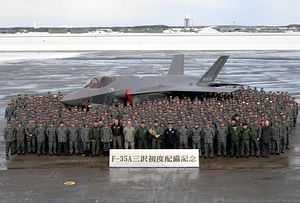The Japan Air Self-Defense Force (JASDF) has deployed its first F-35A Lightning II fifth-generation stealth fighter jet, the conventional take-off and landing (CTOL) variant of the aircraft, at Misawa Air Base in Aomori Prefecture in the northernmost part of Honshu on January 26, Japan’s Ministry of Defense announced last week.
The aircraft constitutes the nucleus of the JASDF’s first operational F-35A squadron with the remaining nine aircraft to be deployed by the end of fiscal year 2018.
“The deployment of the high-performance F-35 aircraft is significant for Japan’s security at a time when neighboring countries have been quickly building up their air force capabilities in recent years,” Defense Minister Itsunori Onodera told reporters on January 26. The deployment takes place in the face of North Korea’s growing military capabilities and aggressive posturing on the Korean Peninsula.
Japan plans to induct a total of 42 F-35As in the coming years. Japan’s first foreign military sales (FMS) F-35A was rolled out on in September 2016 at a Lockheed Martin production facility in Fort Worth, Texas, after it successfully completed its maiden flight in August of the same year (See: “Japan Air Self Defense Force Rolls Out 1st F-35A Stealth Fighter Jet”).
The JASDFs first batch of four F-35As were all built in the United States, while the remaining 38 F-35A aircraft are currently being assembled in Japan. The first F-35A built in Japan was rolled out at the Mitsubishi Heavy Industries (MHI) F-35 Final Assembly and Check Out (FACO) facility in Nagoya in June 2017. While the aircraft is assembled in Japan, it does not include any Japanese-made parts, which has led to some consternation among Japanese defense contractors.
Japan’s F-35A program has also been plagued by cost overruns. “The procurement was estimated at 9.6 billion yen ($88.5 million) for a single plane as of fiscal 2012, but the price tag rose to 17.9 billion yen in fiscal 2016,” Nikkei Asian Review reported on January 27. “Total estimated costs until disposal also increased to 2.22 trillion yen in fiscal 2016, up 16 percent from the fiscal 2012 forecast.” Part of the reason for the higher than expected expenditures is a weaker yen, there are other factors including higher assembly costs at the FACO facility in Nagoya.
The F-35 will be armed with new long-range stand-off missiles, including the precision-guided JSM (Joint Strike Missile), originally developed as an anti-ship missile, with a range of about 500 kilometers (310 miles). “The JSM, co-developed by U.S. defense contractor Raytheon and Norwegian defense company Kongsberg Gruppen, is a fifth-generation cruise missile specifically designed to fit inside the F-35A’s weapons bay to maintain the aircraft’s stealth capabilities,” I explained elsewhere.
However, “the introduction of the missiles is not aimed at targeting enemy military bases. We rely on U.S. strike capabilities for attacking enemy bases and this will remain unchanged,” Onodera emphasized on January 26.
































